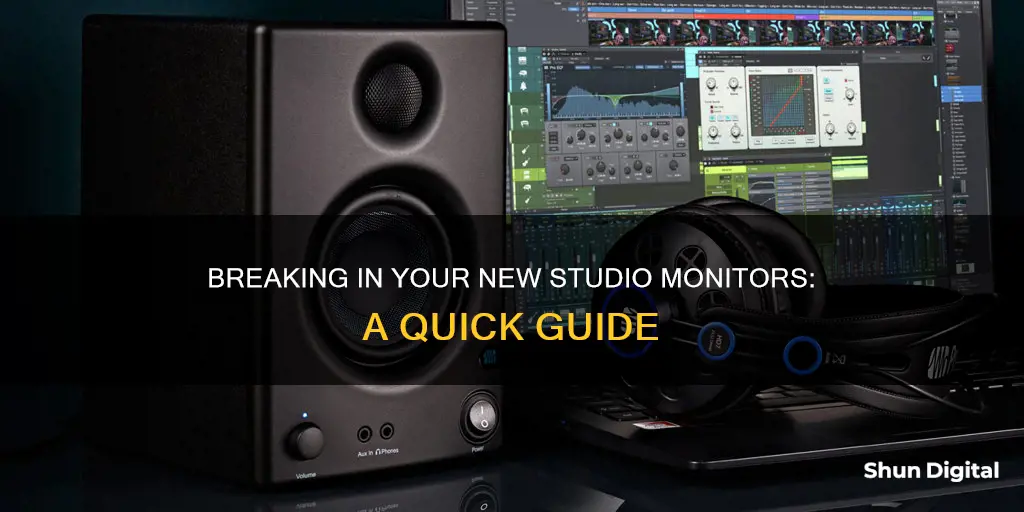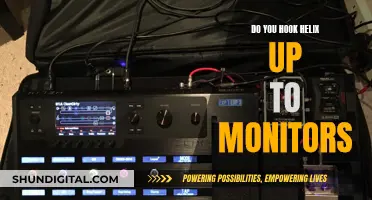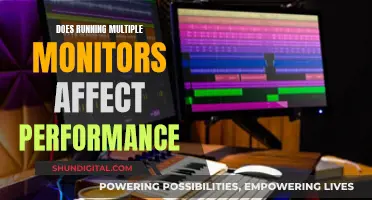
Studio monitors are loudspeakers designed for use in recording studios. They are believed to require a break-in period to perform at their best. This process involves playing music through the monitors for an extended period, typically 12-24 hours, at a moderate volume. While some claim this is a myth, many professionals and manufacturers recommend it, believing it improves sound quality as the speakers loosen up and become more flexible. However, others argue that any physical changes occur almost instantly and are likely to happen during factory testing, rendering the break-in period meaningless.
| Characteristics | Values |
|---|---|
| Purpose | Allow speakers to become more flexible and better able to reproduce sound accurately |
| Music type | A variety of music with a wide frequency range |
| Volume | Moderate to loud |
| Time | 12-24 hours |
What You'll Learn

The importance of breaking in new studio monitors
Studio monitors are loudspeakers specifically designed for use in recording studios. Unlike regular speakers, studio monitors are intended to provide an accurate and flat representation of the sound being recorded, without any artificial enhancements or coloration. This makes them a crucial tool in any recording studio, as they help ensure that the music being recorded and mixed is as true to the original sound as possible.
When you buy a new pair of studio monitors, you might be advised to "break them in" before using them for critical listening. This process typically involves playing music through the monitors at a moderate volume for an extended period, usually around 12-24 hours, although some manufacturers recommend up to 100 hours. But why is this break-in period important, and is it really necessary?
The theory behind breaking in studio monitors is that it allows the speakers to become more flexible and better able to reproduce sound accurately. During the initial use of the speakers, the components are said to loosen up, including the speaker cones and other electrical components, and the magnet strength may shift. This process is often compared to breaking in a new pair of shoes—after a while, they start to feel more comfortable and adapt to your feet. Similarly, by breaking in studio monitors, you are allowing the speakers to settle and adapt to their new environment.
While some people may dismiss the idea of breaking in studio monitors as a myth, many audio professionals and speaker manufacturers recommend it. Several manufacturers even include instructions for a burn-in period within their product documentation. By breaking in your studio monitors, you are following the advice of experts who have designed and created these speakers. Additionally, the break-in period can help prevent the "`burn-in` or `infant death` effect, where speakers may experience a temporary decline in performance, particularly in bass response or overall volume, when they are first used.
It is worth noting that there is some debate and conflicting evidence surrounding the effectiveness of breaking in studio monitors. Some claim that any physical changes that occur in the speakers happen almost instantly during factory testing, rendering any break-in period at home meaningless. Others argue that the benefits of breaking in speakers are more psychological, as it allows the listener to become accustomed to the sound of the new speakers.
However, given the consensus among engineers and the recommendations from manufacturers, it is generally considered good practice to break in studio monitors. By doing so, you can ensure that your speakers are performing at their full potential and providing you with the best sound quality possible.
RMA an ASUS Monitor: A Step-by-Step Guide
You may want to see also

How to break in new studio monitors
The idea of "breaking in" a new pair of studio monitors is a common practice recommended by many audio professionals and speaker manufacturers. It involves playing music through the speakers for an extended period, allowing them to reach their optimal performance before critical listening and use in a recording studio. While some may consider it a myth, others argue that it improves sound quality and helps the speakers become more flexible and accurate in reproducing sound.
The theory behind breaking in studio monitors is that it allows the components to loosen up and the frequency response to "level out." This process is often compared to breaking in a new pair of shoes, as it helps the speakers settle into their new environment and become more comfortable, just like a well-worn pair of shoes. Additionally, it is believed that the magnet strength shifts and the speaker cones loosen during this period, contributing to better sound reproduction.
How to Properly Break In Studio Monitors:
To properly break in your new studio monitors, follow these steps:
- Position the Monitors: Set up your studio monitors in their intended listening position, ensuring they are angled and positioned optimally for the best sound.
- Play a Variety of Music: Play a wide range of music through the monitors at a moderate volume for at least 12-24 hours. This will help loosen the components and improve the speakers' flexibility. It is recommended to play music with a broad range of frequencies, including deep bass tones and sounds in the upper part of the frequency range. However, avoid extremely loud or bass-heavy music during this period, as it can damage the speakers.
- Continue Regular Use: After the initial break-in period, continue using the monitors regularly but avoid exposing them to excessive volume or bass-heavy music. This will help maintain the speakers' flexibility and ensure optimal performance.
- Perform Proper Maintenance: Regularly clean the speakers and check for any damage or wear to ensure they perform at their best over time.
Studio monitors typically only need to be broken in once, immediately after purchase. However, if they haven't been used for an extended period, the materials may stiffen, and you might need to repeat the break-in process to achieve the same effect.
While the concept of breaking in studio monitors remains a subject of debate, many professionals swear by it. By following these steps, you can ensure that your studio monitors are ready to deliver their best performance when you need them.
Performance Monitor vs Task Manager: What's the Difference?
You may want to see also

The science behind breaking in new studio monitors
The "break-in" theory or practice is the idea that new studio monitors need to be "run-in" or "broken in" by being used for a certain period to reach their optimal performance. This theory is supported by many audio professionals and manufacturers, who recommend it in product handbooks and manuals. However, some manufacturers, like Yamaha, do not include such instructions and even advise against it.
The Science Behind the Theory
The theory is based on the idea that the components of studio monitors, particularly the cones, need to "loosen up" and that the magnet strength modifies during this period. This is said to level out the frequency response of the speakers, making them more flexible and better able to accurately reproduce sound. The process is compared to breaking in a new pair of shoes, which initially feel uncomfortable but become more comfortable and adaptable to the wearer's feet over time.
The "Burn-In" or "Infant Death" Effect
Another reason to break in studio monitors is to avoid the "burn-in" or "infant death" effect, where speakers, especially those with powerful bass drivers, experience a temporary decline in performance after initial use. This can manifest as a loss of bass response or a reduction in overall volume. The effect is usually temporary and can be remedied by allowing the speakers to "break in" and become more flexible over time.
How to Properly Break in Studio Monitors
To properly break in studio monitors, it is recommended to play a variety of music through the monitors at a moderate volume for an extended period, typically 12-24 hours, although some manufacturers suggest up to 100 hours. It is important to avoid extremely loud or bass-heavy music during this period, as it can damage the speakers and hinder their ability to break in effectively.
The Debate on the Theory
While many professionals and manufacturers support the "break-in" theory, some argue that it is a myth. They claim that any physical changes that occur in speakers happen almost instantly during factory testing, and any "break-in" done by the consumer is meaningless. Additionally, they suggest that the perceived improvements in sound quality may be due to the listener's ears adjusting to the new speakers rather than any physical changes in the speakers themselves.
In conclusion, while there is debate on the topic, many professionals and manufacturers recommend breaking in new studio monitors to optimise their performance. This process involves playing music at moderate volumes for an extended period to allow the components to loosen and the speakers to become more flexible and adaptable.
Opening an Asus Monitor: Back Panel Access Guide
You may want to see also

How long does it take to break in new studio monitors?
The time it takes to break in new studio monitors varies depending on the manufacturer's instructions and the method used. Some manufacturers recommend a break-in period of around 12-24 hours, while others suggest a longer duration of up to 100 hours. The process typically involves playing music through the monitors at a moderate volume to allow the components to loosen up and become more flexible. However, it's worth noting that there are differing opinions on the effectiveness of breaking in speakers, with some considering it a myth.
To properly break in studio monitors, it is recommended to follow these steps:
- Position the monitors correctly: Set up the studio monitors in their intended listening position, ensuring they are angled and positioned optimally for the best sound.
- Play a variety of music: Play music through the monitors at a moderate volume for at least 12-24 hours. This helps to loosen the components and improve the speakers' ability to reproduce sound accurately. It is recommended to play music with a wide frequency range to test and loosen all frequency responses.
- Avoid loud sounds: Refrain from playing extremely loud or bass-heavy music during the initial break-in period, as it may damage the speakers.
- Continue regular use: After the initial break-in, continue using the monitors regularly but avoid exposing them to excessive volumes or bass-heavy music to maintain their flexibility.
- Perform maintenance: Properly maintain the studio monitors by cleaning the speakers and checking for any damage or wear to ensure optimal performance.
It is worth noting that the break-in process is not universally agreed upon. Some audio professionals and speaker manufacturers believe that while breaking in speakers is not essential for their function, it can enhance their sound quality. On the other hand, some sources suggest that the perceived improvements are mainly psychological, as users become accustomed to the sound of their speakers in their space. Additionally, some manufacturers, like Yamaha, do not recommend breaking in their speakers at all.
Unlocking 144Hz: Setting Up Your ASUS Monitor for Smoothness
You may want to see also

Do you need to break in new studio monitors?
Studio monitors are loudspeakers specifically designed for use in recording studios. Unlike regular speakers, studio monitors are intended to provide a flat and accurate representation of the sound being recorded, allowing audio engineers and producers to hear the music as it actually sounds without any artificial enhancements or coloration.
The concept of breaking in studio monitors
Breaking in studio monitors refers to the idea that new speakers need to be "run-in" or "burned-in" before they can produce their best sound. This theory suggests that a break-in period allows the components of the speakers to loosen up and even out the frequency response, leading to improved sound quality. It is often recommended by manufacturers and audio professionals, who suggest that the speakers will become more flexible and better able to reproduce sound accurately after a break-in period.
The science behind breaking in speakers
While the concept of breaking in speakers is widely accepted in the music industry, there is some debate and skepticism around whether it is necessary or even effective. Some argue that any physical changes that occur in a speaker happen almost instantly during factory testing, rendering any break-in process done by the consumer meaningless. Additionally, any changes that occur as the speaker and enclosure heat up are temporary and return to their original state once cooled.
Methods for breaking in studio monitors
For those who believe in the concept, there are several methods recommended for breaking in studio monitors:
- Positioning the monitors properly in their intended listening position.
- Playing a variety of music, including bass-heavy tracks, at a moderate volume for an extended period, typically between 12 and 24 hours.
- Avoiding extremely loud or bass-heavy music during the initial break-in period to prevent damage to the speakers.
- Continuing to use the monitors regularly after the initial break-in, while avoiding excessive volumes and bass-heavy music to maintain the flexibility of the speakers.
- Performing proper maintenance, including cleaning and checking for damage or wear.
While there is conflicting evidence and opinions on the necessity of breaking in new studio monitors, it is ultimately up to the user to decide whether to incorporate a break-in period. The process may provide peace of mind and help familiarize oneself with the sound of the new speakers, even if the physical changes are minimal or temporary.
Blind Spot Monitor: Standard on Forester Sport?
You may want to see also
Frequently asked questions
The amount of time it takes to break in new studio monitors varies depending on the brand, but it is generally recommended to play music through them for at least 12-24 hours before critical listening. Some manufacturers suggest leaving them on overnight or even for a few days.
It is recommended to play music with a wide frequency range, including bass-heavy music, at a moderate volume. Some people also suggest using white noise or specific music designed for this process, such as pink noise.
Breaking in studio monitors is generally recommended for those who want to get the best sound quality and accurate sound reproduction. If you are not using them for critical listening or music production, you may not need to break them in, but it is still a good practice to do so to reach their full potential.
One potential risk is playing music that is too loud or bass-heavy during the break-in period, as this can cause damage to the speakers. It is also important to be cautious of excessive electricity usage if leaving the monitors on for an extended period.







